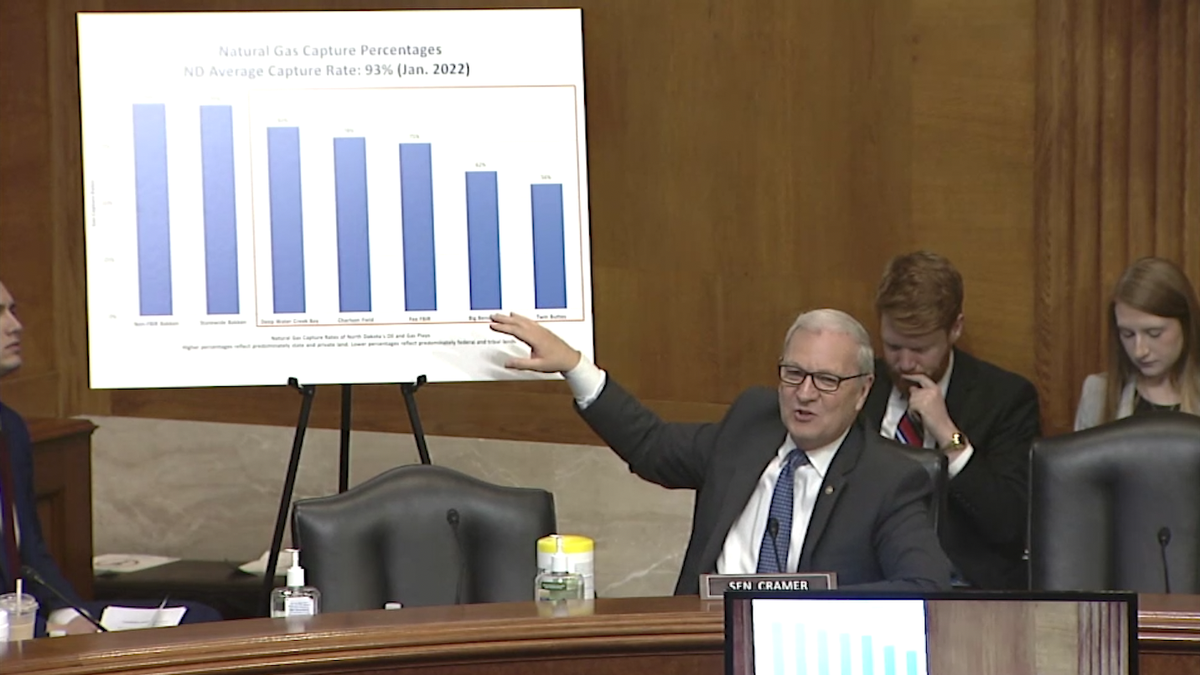Source: United States Senator Kevin Cramer (R-ND)
***Click here to download video. Click here for audio.***
WASHINGTON – U.S. Senator Kevin Cramer (R-ND) highlighted poor methane capture rates on Federal lands – especially when compared to North Dakota state and private lands – and pressed Environmental Protection Agency (EPA) Administrator Michael Regan to work with the North Dakota Department of Agriculture on chlorpyrifos disposal at a Senate Environment and Public Works hearing.
“I remember what you said last week about emission standards and energy production, [those] goals don’t have to be mutually exclusive. I agree with [Senator Whitehouse], we should find more ways to capture natural gas rather than vent and flare it. There’s no productive use of vented and flared natural gas. So let’s work on common goals together,” said Senator Cramer.
Senator Cramer pointed to provisions in the bipartisan Infrastructure Investment and Jobs Act to streamline the regulatory process for the build-out of natural gas infrastructure. He highlighted the vast difference in methane capture rates in North Dakota on state and private lands versus Federal and Indian lands. The chart provided a visual representation of the bureaucratic obstacles hindering better environmental outcomes.
“In the Bakken where we produce a lot of oil, natural gas is a byproduct so we do have some venting and flaring. The range of capture of natural gas from the Bakken oil production range from 56% to 94%. The good news is the state average is 93%. The 94% is all state and private land. The 56% to 83% is largely either tribal land or other Federal lands. We need to do better on Federal lands and Indian lands,” continued Senator Cramer.
Senator Cramer called for increased cooperation between Federal agencies so “we can do the right thing… with a product that’s more valuable being used than vented and flared.” He encouraged Administrator Regan to work with Department of the Interior Secretary Deb Haaland to use the permitting efficiencies the agencies already have from IIJA to increase energy infrastructure that reduces methane emissions.
“I can assure you on that topic DOE, Interior, EPA, [and] CEQ we’re all looking at all the resources that we have [and] our regulation to be sure that we’re going the same direction,” responded Administrator Regan.
Senator Cramer questioned Administrator Regan on a February 23 letter from North Dakota Agriculture Commissioner Doug Goehring regarding the disposal of existing stocks of unusable chlorpyrifos products. He asked for assurances the EPA is not going to punish growers who may currently hold chlorpyrifos given the lack of direction from the Agency and for the EPA to work with state agencies to properly handle disposal.
“Last year, the EPA banned the use of this chemical and gave farmers and retailers six months to dispose of it. The rule came out in August which means winter is coming in North Dakota. The bottom line is farmers have a lot of this stuff on their shelves and they’re coming up on [a deadline] to dispose of it and the same [goes] with retailers if they purchase this in anticipation of the next growing season. There’s been very little to no guidance on how to dispose of it,” said Senator Cramer. “Even in North Dakota the ground is thawing out now. We’re coming up on planting season so if you could raise that to the top and get back to Commissioner Goehring or me that would be really appreciated.”
“I can commit to you that our regional office is working with your state to think about how we navigate that tough terrain that we find ourselves in,” responded Administrator Regan.
